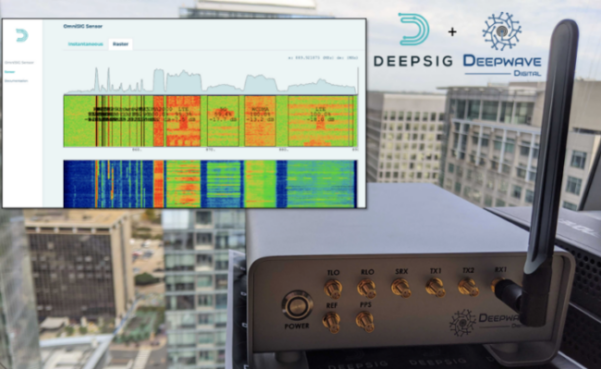Highlighting a wireless sensing solution which leverages components from two separate companies with very similar names, DeepSig and a valued partner, DeepWave.
DeepSig’s Machine Learning software products are designed for agility and ease of integration and operation on a variety of radio platforms. The OmniSIG software operating on DeepWave’s Artificial Intelligence Radio Transceiver (AIR-T) software defined radio (SDR) platform. (https://deepwavedigital.com/hardware-products/sdr/).
The Air-T is designed to be an edge-compute platform and inference engine for deep learning algorithms, leveraging the NVIDIA Jetson TX2 mobile GPU and SoC. In addition to the edge-compute engine, the AIR-T also comes integrated with a radio front end receiver, making this platform an ideal target for embedding OmniSIG software allowing it to both receive and process a wide range of radio sensor data efficiently on the mobile GPU. The AIR-T radio front end leverages the Analog Devices 9371 RFIC which can tune anywhere from 300 MHz to 6 GHz, has a maximum bandwidth of 112.5 MHz and is able to operate using 2 receive channels.
Deploying OmniSIG onto the AIR-T was straightforward with the OmniSIG Debian package deployment option, leveraging pre-built packages for the Jetson TX2 module, and running with the AIR-T radio front end was also seamless as the AIR-T is compatible with the SoapySDR radio library which is supported by OmniSIG as a radio source.
Users will find Air-T’s complete package of both the TX2 and the radio front-end to be a very convenient, deployable sensor platform. When combined with OmniSIG ML software the combo can be used as edge sensor for many different types of applications from 5G interference detection or spectrum sharing to constant out-of-band surveys for rogue or unauthorized electromagnetic interference (EMI). Air-T’s small form factor easily deployable and easily networked, allowing users to physically distribute many sensors, letting OmniSIG detect and process at the edge and send a constant stream of signal recognition results over the network to an aggregator, cloud analytics platform, or database that collects, displays and acts on the sensor information. Conversely the AIR-T also has peripheral interfaces, such as USB 3.0, that can readily support external hard drive use for storage of RF survey results off network or without relying on infrastructure.




